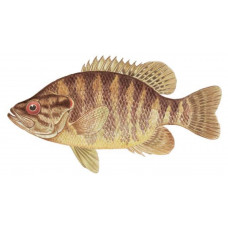Latin name
Lepomis gulosus
Other names
Goggle-eye, openmouth, perch.
Identification
The body is deep, robust, olive brown on top and cream to pale yellow underneath, often with a general purplish sheen and dark brown chain mottling on the back and upper flanks. Dark reddish-brown lines run from the back of each eye. The breeding male has a red-orange spot on the yellow edge of each short ear and dark brown spots and wavy stripes on the fins. It has a large mouth with many teeth on the tongue, and its upper jaw protrudes below or behind the pupils of the eyes. It also has short, rounded pectoral fins and rigid posterior edges of the gill covers.
Distribution
Originally found in the Great Lakes and Mississippi River basins from western Pennsylvania to Minnesota and south to the Gulf of Mexico, they are found in the Atlantic and Gulf drainages from the Rappahannock River in Virginia to the Rio Grande in Texas and New Mexico. They are abundant in the lowlands and less common in the uplands, and have been introduced to many places, including the lower Colorado River, where they are widespread.
Habitat
Warmouth live in relatively shallow, vegetated, slow-flowing streams, ponds, lakes, swamps, and reservoirs with muddy bottoms. They are often found near thickets of weeds, snags, hollow trees or stumps, and under the banks of streams and ponds.
Size
Warmouth can reach a weight of 1 pound and a length of 12 inches. It can live from 6 to 8 years. The world record for all-tackle fishing is a 2-pound, 7-ounce fish caught in Florida in 1985.
Life history and Behavior
Warmouth begin spawning from April to August when they reach 3 to 4 inches in length and are 1 to 3 years old. Spawning peaks in early June when the water warms to about 70°F. The male builds a shallow bowl-shaped nest in water less than 5 feet deep, often in the company of other males, forming a small nesting colony. Preferred nesting sites are sandy or gravelly bottoms with a thin layer of silt, near thickets of lilies, grasses, or at the base of trees standing in shallow water.
Food and feeding habits
The Warmouth feeds on invertebrates, small sunfish, mosquitofish, mosquitoes, crayfish, snails, freshwater shrimp, dragonflies and other insects.
Reproduction
No information
| Classification | |
| Phylum | Chordata |
| Class | Actinopterygii |
| Squad | Perciformes |
| Family | Centrarchidae |
| Genus | Lepomis |
| Species | L. gulosus |
| Features | |
| Conservation status | Least Concern |
| Habitat | Pelagic |
| Life span, years | 8 |
| Maximum body weight, kg | 1 |
| Maximum length, cm | 31 |
| Sailing speed, m/s | No information |
| Threat to people | Edible |
| Way of eating | Predator |
Warmouth
Tags: Warmouth

